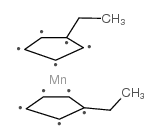101923-26-6
| Name | 2-ethylcyclopenta-1,3-diene,manganese(2+) |
|---|---|
| Synonyms |
Manganocene,1,1'-diethyl
1,1'-Diethylmanganocene MFCD01862452 |
| Boiling Point | ~80ºC(lit.) |
|---|---|
| Molecular Formula | C14H18Mn |
| Molecular Weight | 241.23100 |
| Flash Point | 230 °F |
| Exact Mass | 241.07900 |
| LogP | 3.60340 |
|
Section 1: Product Identification Bis(ethylcyclopentadienyl)manganese, min. 98%, 25-0210, contained in 50 ml Swagelok® cylinder (96-1070) Chemical Name: for CVD/ALD CAS Registry Number:101923-26-6 Formula:[(C2H5)C5H4]2Mn EINECS Number:none
Chemical Family:metallocene Synonym:none Section 2: Composition and Information on Ingredients IngredientCAS NumberPercentACGIH (TWA)OSHA (PEL) Title compound101923-26-6100%0.2mg/m3 (as Mn)5mg/m3 (as Mn- Section 3: Hazards Identification May be irritating to, skin, eyes and mucous membranes. May be harmful if swallowed. Some manganese Emergency Overview: compounds are known to affect the central nervous system. Possible risk of irreversible effects. Primary Routes of Exposure:Inhalation and ingestion Eye Contact:May cause slight to mild irritation of the eyes. Skin Contact:May cause slight to mild irritation of the skin. Vapor or mist may be irritating to the nose, mucous membranes and respiratory tract. May cause chronic Inhalation: health problems. Ingestion:No information available on the physiological effects of ingestion. May be harmful if swallowed. Acute Health Affects:May be irritaitng to the nose, mucous membranes and respiratory tract. Prolonged exposure to manganese containing vapor or mist may produce manganese pneumonitis and Chronic Health Affects:manganese poisoning. Symptoms include sleepiness, weakness and emotional disturbances. Equivocal studies have shown manganese may decrease fertility in men. Possible risk of irreversible effects. NTP:No IARC:No OSHA:No SECTION 4: First Aid Measures Immediately flush the eyes with copious amounts of water for at least 10-15 minutes. A victim may need Eye Exposure: assistance in keeping their eye lids open. Get immediate medical attention. Wash the affected area with water. Remove contaminated clothes if necessary. Seek medical assistance if Skin Exposure: irritation persists. Remove the victim to fresh air. Closely monitor the victim for signs of respiratory problems, such as difficulty Inhalation: in breathing, coughing, wheezing, or pain. In such cases seek immediate medical assistance. Seek medical attention immediately. Keep the victim calm. Give the victim water (only if conscious). Induce Ingestion: vomiting only if directed by medical personnel. SECTION 5: Fire Fighting Measures Flash Point:no data Autoignition Temperature:no data Explosion Limits:no data Extinguishing Medium:carbon dioxide, foam or dry powder If this product is involved in a fire, fire fighters should be equipped with a NIOSH approved positive pressure Special Fire Fighting Procedures: self-contained breathing apparatus and full protective clothing. Hazardous Combustion andIf involved in a fire, this material may emit toxic and corrosive fumes. Decomposion Products: Unusual Fire or Explosion Hazards: Highly flammable. Formation of explosive air/dust mixtures is possible. SECTION 6: Accidental Release Measures Small spills can be mixed with vermiculite, sodium carbonate or other suitable non-combustible adsorbent and Spill and Leak Procedures: swept up. SECTION 7: Handling and Storage Handle and store the material under an inert atmosphere of nitrogen or argon. Keep in a cool, dry Handling and Storage: well-ventilated area. Prolongrd exposure to air or moisture will result in degradation of the product. SECTION 8: Exposure Controls and Personal Protection Eye Protection:Always wear approved safety glasses when handling a chemical substance in the laboratory. Skin Protection:Wear protective clothing and gloves. Ventilation:Handle the material in an efficient fume hood. If ventilation is not available a respirator should be worn. The use of respirators requires a Respirator Respirator: Protection Program to be in compliance with 29 CFR 1910.134. Ventilation:Handle the material in an efficient fume hood. Additional Protection:No additional protection required. SECTION 9: Physical and Chemical Properties Color and Form:dark red liq. Molecular Weight:241.23 Melting Point:not applicable Boiling Point:no data Vapor Pressure:0.1 torr @ 50-65° Specific Gravity:no data Odor:none Solubility in Water:reacts with water SECTION 10: Stability and Reactivity Stability:air sensitive, moisture sensitive Hazardous Polymerization:no hazardous polymerization contact with moisture and oxygen. Keep away from heat and ignition sources including open flame and Conditions to Avoid: electostatic discharge. Incompatibility:air, oxidizing agents, halogens, protoc agents Decomposition Products:Carbon dioxide, carbon monoxide, organic fumes and manganese oxide. SECTION 11: Toxicological Information RTECS Data:No information available from the RTECS files. Carcinogenic Effects:no data Mutagenic Effects:Possible mutagen (as Mn) Tetratogenic Effects:no data SECTION 12: Ecological Information Ecological Information:No information available. SECTION 13: Disposal Considerations Disposal:Dispose of this material according to local, state and federal regulations. SECTION 14: Transportation Shipping Name (CFR):Flammable solids, Organic, N.O.S. Hazard Class (CFR):4.1 Additional Hazard Class (CFR):NA Packaging Group (CFR):II UN ID Number (CFR):UN# 1325 Shipping Name (IATA):Flammable solid, Organic, N.O.S. Hazard Class (IATA):4.1 Additional Hazard Class (IATA):NA Packaging Group (IATA):II UN ID Number (IATA):UN# 1325 SECTION 15: Regulatory Information TSCA:Not listed in the TSCA inventory SARA (Title 313):See Category code N450 for reporting Second Ingredient:none SECTION 16 - ADDITIONAL INFORMATION N/A |
| Hazard Codes | F: Flammable;Xi: Irritant; |
|---|---|
| Risk Phrases | R17 |
| Safety Phrases | 26 |
| RIDADR | UN 3392 4.2/PG 1 |
